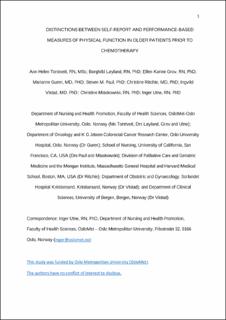Distinctions Between Self-Report and Performance-Based Measures of Physical Function in Older Patients Prior to Chemotherapy
Torstveit, Ann Helen; Løyland, Borghild; Grov, Ellen Karine; Guren, Marianne; Paul, Steven M.; Ritchie, Christine; Vistad, Ingvild; Miaskowski, Christine; Utne, Inger
Journal article, Peer reviewed
Accepted version
Permanent lenke
https://hdl.handle.net/11250/2986099Utgivelsesdato
2021Metadata
Vis full innførselSamlinger
- Department of Clinical Science [2318]
- Registrations from Cristin [9791]
Sammendrag
Background: The maintenance of physical function (PF) is an extremely important outcome for older adults. Objective: The aims of this study were to, identify differences in subjective and objective measures of PF between younger older adults (YOA, 60-69 years of age) and older adults (OA, ≥70 years of age); compare the PF scores with age-matched samples from the general population; and evaluate for associations between subjective and objective measures of PF. Methods: Patients (n=139) were assessed using subjective (i.e., European Organization for Research and Treatment of Cancer Core Quality-of-Life Questionnaire (QLQ-C30)) and objective (i.e., Short Physical Performance Battery (SPPB)) measures prior to chemotherapy (CTX). Data were analyzed using parametric and nonparametric tests. Results: No differences were found between the two age groups in any of the subjective or objective measures of PF. Compared to the age-matched general population; both YOA and OA had significantly lower scores in both measures of PF. Large effect sizes were found for differences in QLQ-C30 role function, SPPB balance, and SPPB total scores between the YOA group and the age-matched general population samples. Correlations between the subjective and objective measures were low. Conclusions: Older patients with cancer have lower PF than their age matched general population prior to CTX. Longitudinal studies are warranted to evaluate for changes in PF during and following CTX. Implications for Practice: Nurses need to perform routine assessments of PF in older oncology patients prior to CTX. Our findings suggest that SPPB gait speed may be a useful screening measure for PF in older patients.

